NCERT Solutions Class 10 Maths
Chapter – 6 (Triangles)
The NCERT Solutions in English Language for Class 10 Mathematics Chapter – 6 Triangles Exercise 6.4 has been provided here to help the students in solving the questions from this exercise.
Chapter : 6 Triangles
- NCERT Class 10 Maths Solution Ex – 6.1
- NCERT Class 10 Maths Solution Ex – 6.2
- NCERT Class 10 Maths Solution Ex – 6.3
- NCERT Class 10 Maths Solution Ex – 6.5
- NCERT Class 10 Maths Solution Ex – 6.6
Exercise – 6.4
1. Let ΔABC ~ ΔDEF and their areas be, respectively, 64 cm2 and 121 cm2. If EF = 15.4 cm, find BC.
Solution – Given, ΔABC ~ ΔDEF,
Area of ΔABC = 64 cm2
Area of ΔDEF = 121 cm2
EF = 15.4 cm
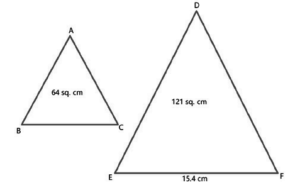
Therefore,
⇒
⇒ (BC)² =
⇒ BC =
⇒ BC = 11.2 cm
2. Diagonals of a trapezium ABCD with AB || DC intersect each other at the point O. If AB = 2CD, find the ratio of the areas of triangles AOB and COD.
Solution – Given, ABCD is a trapezium with AB || DC. Diagonals AC and BD intersect each other at point O.
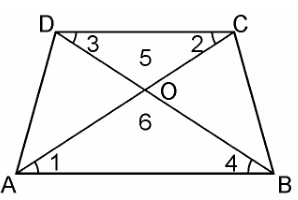
In ΔAOB and ΔCOD, we have
∠1 = ∠2 (Alternate angles)
∠3 = ∠4 (Alternate angles)
∠5 = ∠6 (Vertically opposite angle)
∴ ΔAOB ~ ΔCOD [AAA similarity criterion]
As we know, If two triangles are similar then the ratio of their areas are equal to the square of the ratio of their corresponding sides. Therefore,
Area of (ΔAOB)/Area of (ΔCOD) = AB2/CD2
= (2CD)2/CD2 [∴ AB = 2CD]
∴ Area of (ΔAOB)/Area of (ΔCOD)
= 4CD2/CD2 = 4/1
Hence, the required ratio of the area of ΔAOB and ΔCOD = 4 : 1
3. In the figure, ABC and DBC are two triangles on the same base BC. If AD intersects BC at O, show that area (ΔABC)/area (ΔDBC) = AO/DO.
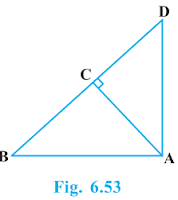
Solution – Given : ABC and DBC are triangles on the same base BC. Ad intersects BC at O.
To Prove : area (ΔABC)/area (ΔDBC) = AO/DO.
Construction : Let us draw two perpendiculars AP and DM on line BC.
Proof : We know that area of a triangle = × Base × Height

In ΔAPO and ΔDMO,
∠APO = ∠DMO (Each equals to 90°)
∠AOP = ∠DOM (Vertically opposite angles)
∴ ΔAPO ~ ΔDMO (By AA similarity criterion)
∴ AP/DM = AO/DO
⇒
4. If the areas of two similar triangles are equal, prove that they are congruent.
Solution – Say ΔABC and ΔPQR are two similar triangles and equal in area
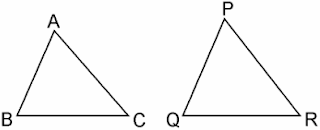
Now let us prove ΔABC ≅ ΔPQR.
Since, ΔABC ~ ΔPQR
∴ Area of (ΔABC)/Area of (ΔPQR) = BC2/QR2
⇒ BC2/QR2 = 1 [Since, Area(ΔABC) = (ΔPQR)
⇒ BC2/QR2
⇒ BC = QR
Similarly, we can prove that
AB = PQ and AC = PR
Thus, ΔABC ≅ ΔPQR [SSS criterion of congruence]
5. D, E and F are respectively the mid-points of sides AB, BC and CA of ΔABC. Find the ratio of the area of ΔDEF and ΔABC.
Solution –
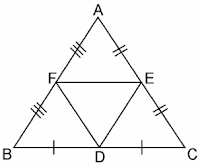
Given : D, E and F are the mid-points of the sides AB, BC and CA respectively of the ΔABC.
To Find : area(ΔDEF) and area(ΔABC)
Solution : In ΔABC, we have
F is the mid point of AB (Given)
E is the mid-point of AC (Given)
So, by the mid-point theorem, we have
FE || BC and FE = BC
⇒ FE || BC and FE || BD [BD = BC]
∴ BDEF is parallelogram [Opposite sides of parallelogram are equal and parallel]
Similarly in ΔFBD and ΔDEF, we have
FB = DE (Opposite sides of parallelogram BDEF)
FD = FD (Common)
BD = FE (Opposite sides of parallelogram BDEF)
∴ Δ FBD ≅ Δ DEF
Similarly, we can prove that
ΔAFE ≅ ΔDEF
ΔEDC ≅ ΔDEF
If triangles are congruent,then they are equal in area.
So, area (ΔFBD) = area (ΔDEF) ————- (i)
area (ΔAFE) = area (ΔDEF) ————- (ii)
and, area (ΔEDC) = area (ΔDEF) ————- (iii)
Now,
area (ΔABC) = area (ΔFBD) + area (ΔDEF) + area (ΔAFE) + area (ΔEDC) ————- (iv)
area (ΔABC) = area (ΔDEF) + area (ΔDEF) + area (ΔDEF) + area (ΔDEF)
⇒ area (ΔDEF) = area (ΔABC) [From (i), (ii) and (iii)]
⇒ area (ΔDEF)/area (ΔABC) =
Hence,
area (ΔDEF) : area (ΔABC) = 1 : 4
6. Prove that the ratio of the areas of two similar triangles is equal to the square of the ratio of their corresponding medians.
Solution – Given : AM and DN are the medians of triangles ABC and DEF respectively and ΔABC ~ ΔDEF.
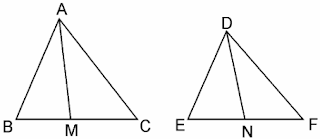
We have to prove : Area(ΔABC)/Area(ΔDEF) = AM2/DN2
Since, ΔABC ~ ΔDEF (Given)
∴ Area(ΔABC)/Area(ΔDEF) = (AB2/DE2) ——————-(i)
and, AB/DE = BC/EF = CA/FD ——————-(ii)

In ΔABM and ΔDEN,
Since ΔABC ~ ΔDEF
∴ ∠B = ∠E
AB/DE = BM/EN [Already Proved in equation (i)]
∴ ΔABC ~ ΔDEF [SAS similarity criterion]
⇒ AB/DE = AM/DN ———————— (iii)
∴ ΔABM ~ ΔDEN
As the areas of two similar triangles are proportional to the squares of the corresponding sides.
∴ area (ΔABC) /area (ΔDEF) = AB2/DE2 = AM2/DN2
7. Prove that the area of an equilateral triangle described on one side of a square is equal to half the area of the equilateral triangle described on one of its diagonals.
Solution –
Given : ABCD is a square whose one diagonal is AC. ΔAPC and ΔBQC are two equilateral triangles described on the diagonals AC and side BC of the square ABCD.
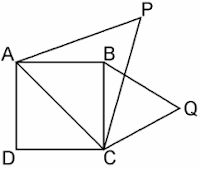
Area(ΔBQC) = ½ Area(ΔAPC)
Since, ΔAPC and ΔBQC are both equilateral triangles, as per given,
∴ ΔAPC ~ ΔBQC [AAA similarity criterion]
∴ area(ΔAPC)/area(ΔBQC) = (AC2/BC2) = AC2/BC2
Since, Diagonal = √2 side = √2 BC = AC
⇒ area (ΔAPC) = 2 × area (ΔBQC)
⇒ area (ΔBQC) = area (ΔAPC)
8. ABC and BDE are two equilateral triangles such that D is the mid-point of BC. Ratio of the area of triangles ABC and BDE is
(A) 2 : 1
(B) 1 : 2
(C) 4 : 1
(D) 1 : 4
Solution – Given, ΔABC and ΔBDE are two equilateral triangle. D is the midpoint of BC.
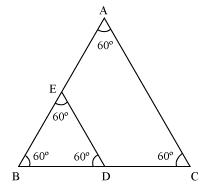
∴ BD = DC = 1/2 BC
Let each side of triangle is 2a.
As, ΔABC ~ ΔBDE
∴ Area(ΔABC)/Area(ΔBDE) = AB2/BD2 = (2a)2/(a)2 = 4a2/a2 = 4/1 = 4 : 1
Hence, the correct answer is (C).
9. Sides of two similar triangles are in the ratio 4 : 9. Areas of these triangles are in the ratio
(A) 2 : 3
(B) 4 : 9
(C) 81 : 16
(D) 16 : 81
Solution – Given, Sides of two similar triangles are in the ratio 4 : 9.
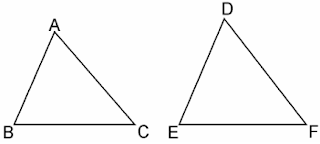
Let ABC and DEF are two similar triangles, such that,
ΔABC ~ ΔDEF
And AB/DE = AC/DF = BC/EF = 4/9
As, the ratio of the areas of these triangles will be equal to the square of the ratio of the corresponding sides,
∴ Area(ΔABC)/Area(ΔDEF) = AB2/DE2
∴ Area(ΔABC)/Area(ΔDEF) = (4/9)2 = 16/81 = 16 : 81
Hence, the correct answer is (D).

